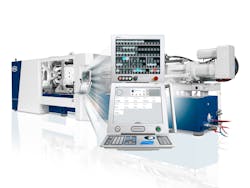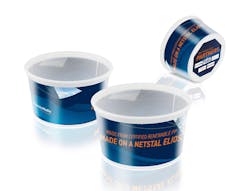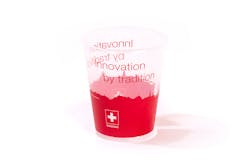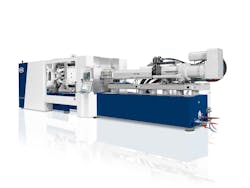Resin costs, sustainability concerns drive push for thinner-walled packaging
By Bruce Geiselman
Thin-wall containers save manufacturers money by reducing resin costs, and they have environmental advantages, according to manufacturers of injection molding machines (IMMs).
For years, the European market has been demanding thinner containers, but in recent years, demand also has been growing in the U.S., Membrino said.
“At Netstal, we’ve been doing it since the ’80s,” said Membrino, who has worked for the company — a part of KraussMaffei — for 25 years. “It seems to have started in Europe, and now, it’s coming this direction.”
Rising resin prices in recent years have driven manufacturers to continue trying to reduce the thickness of containers while still offering good packaging that can transport food safely.
“There was a point where they couldn’t get resin,” Membrino said. “That was a challenge. So, you’ve got to use less then. But I’ve also heard of [resin prices] going up 30 percent to 50 percent. Now, they’re starting to come back down a little bit, but who knows when that next jump is going to happen?”
“Pretty much all Netstal does is thin-wall packaging of some sort,” he said. “If we’re doing packaging, it’s thin wall. Everything we do is based on that high-performance platform.”
A definition of thin-wall containers can be subjective, but a ratio of flow length to thickness (L/T) above 150 to 200 is generally considered thin-wall injection molding, Membrino said.
Not all injection molding equipment is capable of the task.
“It’s got to be fast; it’s got to be precise, and it’s got to be reliable,” Membrino said.
“The biggest challenge is you have to inject that material and have that flow front get to the end before it freezes off,” he said. “The thinner the part, the harder that is, because the material wants to freeze off during the injection. You have to get it in there as fast as possible.”
That means IMMs must be fast, with injection times typically about one-tenth to one-fifth of a second, and with injection pressures greater than 30,000 pounds per square inch (PSI). Molds also must be balanced and fill accurately to consistently produce thin, lightweight parts.
Customers today also are placing a greater emphasis on energy efficiency, Membrino said.
“Before, it was just put on more accumulators, more hydraulics and higher pressures, but now, we’re actually looking more and more at the sustainable side of it and making the machines more energy-efficient. That means you’re going to have electric drives; you’re going to have energy-recover systems, so, when one system is braking, the other one is taking up that energy and using it in another function.”
To further improve energy efficiency, Netstal recently introduced an adaptive pressure-reduction option for hybrid IMMs. To ensure Netstal presses can handle peak loads, the hydraulic system of the company’s hybrid machines is designed for a maximum operating pressure of about 3,600 PSI. However, depending on the application, less pressure might be sufficient. The adaptive system, introduced in February, determines the optimum pressure required for a particular part and adjusts the pressure accordingly. Decreasing the operating pressure can reduce energy costs, greenhouse gas emissions, ease wear on components, extend maintenance intervals and ensure longer IMM life. The feature is available as an option for all hybrid Netstal IMMs running version 8.6.0 aXos controllers, and can be retrofitted to existing machines.
Also, in a move to improve energy efficiency in manufacturing thin-wall containers and packaging, Netstal’s Elios 4500, with 505 tons of clamping force, is the first IMM in the Elios line to feature an all-electric clamping unit, which improves energy efficiency and significantly shortens dry-cycle time.
The Elios line is designed for customers needing larger tie-bar spacing and greater clamping forces for higher cavitation systems.
In tests, the result of using an all-electric clamping unit reduced dry-cycle time by 0.1 second to 1.4 seconds, and energy consumption was reduced by 7 kilowatts compared to the original hybrid clamp. The elimination of the hydromechanical components for operating the toggle lever used on the hybrid clamping machines also results in an overall machine length that is 17.7 inches shorter, saving floor space.
The larger Elios units, with clamping forces ranging from 618 tons to 1,124 tons, continue to use hybrid clamping units.
The Elion line of IMMs, also used for thin-wall packaging, are hybrid presses with all-electric clamping units. However, they are smaller units, with clamping force from 135 tons to 472 tons.
While it is more challenging to use an all-electric clamping unit with larger machines, recent trends indicate growing demand for the technology.
Another recent trend involves growing interest in molding thin-wall containers with biomaterials, or 100 percent plant-derived polymers, Membrino said.
At the France Innovation Plasturgie trade show in April in Lyon, France, Netstal presented a demonstration of how a Netstal Elion series IMM could produce a drinking cup using Kaneka Biodegradable Polymer Green Planet, a 100 percent bio-based polymer. It is produced by a microorganism fermentation process in which bio-based oils are used as primary raw materials. Microorganisms in the environment can digest the polymer, leaving behind carbon dioxide and water. The polymer can be processed for use in various applications including straws, shopping bags, cutlery and food packaging. The material is home-compostable and industrial-compostable, Membrino said.
Netstal also has been working for several years with partners on an injection compression molding (ICM) process that results in significant material and energy savings, according to the company.
Netstal in 2015 developed a compression molding process on a 4+4 stack mold in conjunction with mold maker Plastisud SAS, Castelnaudary, France. Netstal says it was the packaging industry’s first ICM system on a stack mold.
“We were able to use injection compression, where you inject into an open mold and then clamp up on it during injection to fill out the rest of the product,” Membrino said. “It’s not a completely injection molded part. It’s actually stamped to fill the part completely. This requires a very stable mold, a stable machine, and a very precise injection in order to do it.”
Netstal has been offering the system for a number of years, Membrino said. “There aren’t a lot of systems out there, but there is huge potential, especially when it comes to lids. I think the lids are a huge area that we could have some growth. The reason is a flat panel on a lid tends to cup if it's under stress, and if we can do that injection-compression wise, we can make it super thin, without causing all kinds of stress during that injection phase.”
SABIC-Netstal partnership
Netstal and SABIC, a Saudi Arabia-headquartered chemical company, partnered to open in 2021 a thin-wall application center in Näfels, Switzerland, where Netstal is headquartered. At this center, the two companies are collaborating to optimize ICM technologies.
“The whole idea of the joint technical center is to do tests for customers on thin-wall containers,” said Christina Härter, head of application engineering at Netstal Maschinen AG. “It’s nice to learn from each other about the product. SABIC is able to learn about machines and processes, and we learn a lot about materials and processes.”
Collaboration between a materials supplier and an equipment manufacturer is important to advance thin-wall injection molding, particularly in the field of packaging, where conventional injection molding has reached its limits in terms of reducing wall thicknesses, according to a paper on ICM of thin-wall packaging authored by Härter; Bart van der Aar, a senior scientist at SABIC’s Technology & Innovation department in the rigid packaging segment; and Reto Gmür, application manager for packaging at Netstal. The collaboration will accelerate advances that lead to material and energy savings.
ICM is commonly used in automotive and optical applications, but adopting the technology for thin-wall packaging is challenging because of differences in material types, part geometries and machine setups, according to SABIC and Netstal.
Materials typically used in thin-wall packaging include PP homopolymers, random copolymers and impact copolymers in melt-flow ranges of 50 grams or greater weight per 10 minutes.
“Typically, high-flow materials come at the cost of losing mechanical performance. The material development for ICM applications focuses on eliminating this constraint,” according to the paper.
Trials at the thin-wall packaging application center demonstrated significant benefits when ICM is performed with proper materials, optimized molds and application design, according to the paper. In the case of an airline cup, researchers discovered that the injection pressure could be decreased by up to 50 percent compared with injection molding, while wall thickness and weight were reduced by 20 percent.
For proper ICM process settings, users need functions that are not normally available in the controls of conventional IMMs. With its aXos control system, Netstal now provides several screens for selecting and setting ICM-specific parameters involving clamping force.
In addition, a newly developed timing diagram helps users visualize critical process values unique to ICM.
“We, up to now, were not focused on having a visualization of the ICM process on our control unit,” Härter said. “So, you were able to program it, but some parameters were not as explicitly shown as people who work with ICM would appreciate.”
Another new control feature addresses process safety during ICM.
The safety strategies incorporated in the standard control of injection molding machines will not suffice if the machine is set to run an ICM process, since there is no function available to monitor the force at the compression gap,” according to the paper. “The mold protection in Netstal’s ICM control system monitors the force at the compression gap and compression end, which means that trapped parts will be safely detected by the machine.”
The companies already are working on possible additional improvements, but they are not yet available, Härter said.
Bruce Geiselman, senior staff reporter
Contact
Kaneka Corp., Tokyo, Japan, www.kaneka.co.jp/en
Netstal Inc., Hebron, Ky., 859-414-2435, www.netstal.com
About the Author
Bruce Geiselman
Senior Staff Reporter Bruce Geiselman covers extrusion, blow molding, additive manufacturing, automation and end markets including automotive and packaging. He also writes features, including In Other Words and Problem Solved, for Plastics Machinery & Manufacturing, Plastics Recycling and The Journal of Blow Molding. He has extensive experience in daily and magazine journalism.





